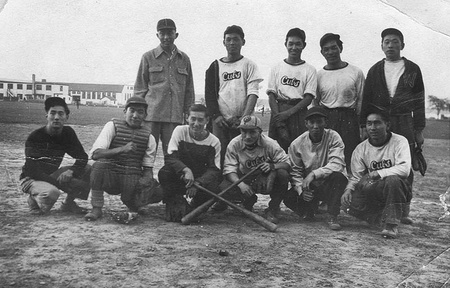Whenever I get together with Nisei these days to recollect the “old days” that invariably mean the years of internment and immediately after the war, the names, dates and places are, like the sepia-tone pictures, beginning to fade and brown around the edges. The details of our collective story are beginning to be forgotten before they have even really been told, really.
When you look at this team picture from Hamilton, are any of the faces familiar? Do any of these names ring a bell? Ken Hashimoto, Tosh Hashimoto, Mike and Roy Honda, Herb and Mits Izumi, Chester Kariatsumari, Hank, Kirk and Tom Kawamoto, Jim, Hank and Shores Kondo, Kaz Kadonaga, Tim, Kats, Tosh or Mac Oikawa, Basil Shintani, Sam Sonoda, Eiji Suzuki, George and Stumpo Uchida, Wally Fukumoto, “Butch” Nishimura or “Mousey” Matsuda?
If you grew up in the Hamilton area in Ontario, Canada (50 miles west of Toronto), do you remember the “Hynoters” or “Sophy-Ed” youth clubs? Singer and pianist Katie Oyama? Or what about judo sensei Masato Ishibashi, Frank Kawasaki, the Umetsu brothers or kendo teachers Mr. Kawamoto and George Kumagai?
I have been fortunate to be able to get to know Nisei Jim Koyanagi, 81, over the past couple of years. The retired architect lives in Burlington with his artist wife, Kumiko-san. Jim has been after me for a while to write something about the Hamilton Nisei recreation baseball league, which was one of the ways that the Nikkei diaspora used to deal with the “circumstances” at the time. For a bunch of young Nisei who had been constantly kicked around by their own government and told that they didn’t belong anywhere, really, ending up in Steeltown must have been a bit of a reprieve. On the baseball diamond, at least, they could show off their athletic prowess, being free, to some extent, from the racism that still had a stranglehold on the Canadian consciousness.
Jim was born in 1928 in Eburn, BC, on Sea Island, close to the present-day Vancouver International Airport. George Matsuda, 82, was born in Vancouver. Frank Shimoda was born in 1934 and Tosh Hashimoto was born in 1924.
In the days when there were few Nisei role models, the Asahi baseball team members were idols in the Vancouver community at a time when being Nikkei barred one from many professions even if you went to the University of British Columbia like Tom Shoyama, the future federal cabinet minister in the Trudeau government.
Frank, married to Miyoko, recalls, “During internment in Bayfarm, BC, my three brothers were sent to Angler and spent some time there. The rest of the family and I went to Slocan, New Denver, then Hamilton.” He went to Westdale Secondary School, working for the city’s department of public health after going to Ryerson and getting his degree as an environmental officer.
Jim points out, “Frank’s eldest brother, Bob Yukio, died in a 1956 plane crash. He was very active as one of the leaders of the Nisei Mass Evacuation Group that was a rare opposing voice, at the time, against internment.”
“I was so young then,” continues Frank. “My family came to Hamilton in ‘47-48. We started to branch out more in respect to becoming more integrated. We got so-called hakujin friends and after that we still stuck together in a way because we did have teenage clubs for the Nisei. We had a basketball team, too, that played against hakujin teams. We had a much better life because we didn’t have to worry about settling down and getting a house. My older brother Bob worked at Canadian Porcelain. Two other brothers, Mits and Harold, retired from there. One of my sisters, Amy, was a dressmaker and married a Maikawa, Tak, Mickey’s (the Asahi player) younger brother. Kim married Ron Grant, the Montreal journalist and writer, who passed away in 2009.
Getting back to baseball, Frank adds, “I remember in Bayfarm, there was a version of Asahi team that came to play a Slocan team and I remember everybody talking about a guy, Kaz Suga. He was a pitcher. His brother Ty was a catcher. He was a pretty good hitter too. I think that he played in Quebec after the war. That was awesome to see him play.” There was a diamond there and games were frequent. Kaz was interned at LC (Lemon Creek Internment Camp).
All of the camps had their own teams and some even had their own leagues. Most camps had an Asahi player to organize teams. Kaslo had “Nagy” Nishihara; New Denver, George Yoshinaka; Slocan had several; and LC had Kaz Suga.
Tosh Hashimoto was born in Vancouver, went to technical school in Vancouver; J-school too. He chummed around with older Nisei and when the evacuation tore the community from the Pacific coast, he went to a friend’s place “voluntarily” in Salmon Arm, BC. for a couple of months. When asked to leave, he went to Vernon which was a restricted area for “commando soldiers.” The RCMP found out we were there so we were sent to Hastings Park again. Tosh recalls widespread diarrhea problems, asking his parents to send food and receiving onigiri from his mom every day.
“The Vernon farmers went to bat for us and told the BC Security Commission that we were needed there as apple pickers,” he recalls, “so we were allowed to return there. After 3 to 4 years there we were allowed to join our parents in the Slocan or wherever they were.”
© 2011 Norm Masaji Ibuki






